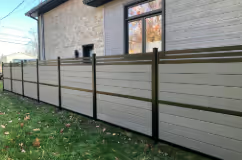Clôtures LM
The reference for your fence on the South Shore. Since 2008, we have offered expert service and durable installations.
.avif)

.avif)
.avif)
.avif)
Summer means swimming and fun, but also safety. The Government of Quebec has implemented the Residential Swimming Pool Safety Regulation to prevent drownings, especially among young children. An important deadline is fast approaching: September 30, 2025.
As of this date, all residential pools, without exception, must comply with the current standards. Do you think you're protected by a "grandfather clause" because your pool was installed before 2010? Think again. That exemption is ending.
As fence experts, we've prepared this guide to help you understand the requirements and ensure your installation is not only safe but also fully legal.
The most important point of the new regulation is the end of grandfather clauses for pools installed before November 1, 2010. If you are one of these homeowners, you have until September 30, 2025, to complete the necessary upgrades to meet the standards. For all other pools, compliance is already mandatory.
The regulation applies to any outdoor pool (in-ground, semi-in-ground, above-ground, or portable models like inflatable pools) that can hold 60 cm (24 inches) of water or more.
(Spas (except those over 2000 liters), natural water ponds, and water gardens are not covered by this regulation.)
The main goal of the law is to prevent a young child from easily accessing the pool. To achieve this, an enclosure (fence) is mandatory to control access.
It's simple: they must be surrounded by a fence. Discover the solutions we offer on our in-ground pool fences page.
The rule depends on the height of your pool's wall:
A pool fence is more than just a simple boundary. It must meet strict criteria to be considered safe.
Safety doesn't stop at the fence. Think about the pool's entire environment:
The provincial regulation establishes the minimum standards. However, your municipality has the right to impose stricter rules. Before undertaking any work, it is imperative to contact your city's planning department to:
Non-compliance with the regulation can result in fines ranging from $500 to over $1000, not to mention the tragic risk that a non-compliant installation represents. To help you validate your installation and understand all the details, the government provides a self-assessment form and a complete application guide.
The September 30, 2025 deadline is approaching quickly. Don't take any risks with the safety of your loved ones and the compliance of your installation.
Contact us today for an assessment of your situation and a free quote. Our team will ensure that your new fence meets all current standards, while perfectly harmonizing with your landscaping.